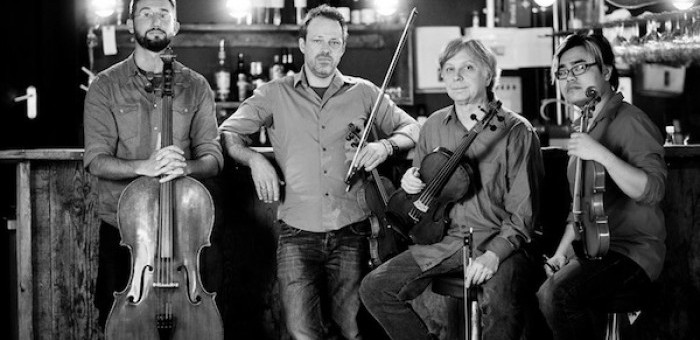Apr 2, 2024 12:59 PM
Saxophonist, Sonic Explorer Casey Benjamin Dies at 45
Casey Benjamin, the alto saxophonist, vocalist, keyboardist and producer who stamped his distinctive sounds on the…

Sirius Quartet
(Photo: Philip Nemenz)On the pleasantly mild and not entirely calm night of June 17, aboard a gently rocking boat that has been docked off of Brooklyn Ferry Landing for almost 40 years, the Sirius Quartet presented a unique blend of composition and improvisation—something that they have been pursuing for more than 30 years.
The boat, christened Bargemusic, is one of New York City’s finer non-hall venues for classical music, with windows behind the stage looking out onto the East River and Lower Manhattan. Even though Sirius isn’t a classical group, the program did begin with a work by the baroque composer Henry Purcell and included a piece by American iconoclast Charles Ives.
To the extent that such things can be delineated, Sirius didn’t strike the appearance of a classical quartet, either. If anything, they looked like an old-time string band. And when, during violinist Gregor Huebner’s Purcell arrangement, violist Ron Lawrence bore down on his bow and cellist Jeremy Harman lapsed into a walking bass line, they gave some indication of their love for jazz.
Also unlike the traditional string quartet, the members of Sirius write much of their own material. The quartet’s new album, Paths Become Lines (Autentico Music/Naxos) features compositions by each member, as did the better part of the June 17 concert.
The quartet followed the Purcell revisions with the piece by Harman that gave the new album its title. A quick and heavy pulse set the foundation, eventually giving way to a pair of violin solos, blistering from Huebner, more melodic from Fung Chern Hwei. The two then escalated in a tandem improvisation before anchoring again for a tight conclusion.
Fung introduced his song “Ceili” as a “moment of tranquility or nostalgia after a huge festivity or celebration. When everybody left, all you saw was an empty room.” A plucked meter set by Lawrence, holding his viola flat against his chest, was soon picked up by the violins against a plaintive melody from the cello that painted the scene before Fung picked up the melody line for a melancholy solo.”
Introducing a single movement from Ives’ 1913 Quartet No. 2, Lawrence said, “I think you’ll hear that he was listening to a lot of John Zorn when he wrote this,” drawing a bit of knowing laughter. The quartet played the piece forcefully, with hard unison lines breaking for solo violin or romantic ensemble fragments. Even the boat seemed to pick up the tempo of its rocking. It also seemed to give them the energy they needed to attack Harman’s interlocking and layered “More Than We Are.”
As if to ensure they met the requirements of playing an ordinarily classical venue, the group closed with what Huebner introduced as “a whole string quartet,” his String Quartet No. 4, Opus 44, “The Wollheim Quartet.” This was the most formal delivery of the evening, with distinct parts and no gray areas.
The brisk first movement contrasted sharply with the long, overlapping tones and delicate dissonances of the second, with a lovely unaccompanied cello passage that Harman played magnificently, bowing most of it while adding expression with his left hand against the fingerboard. The rest of the strings returned with a fantastic fluidity, Huebner adding a percussive arco twist. The work was the high point of the evening, only strengthened by the comparatively freer interplay that preceded it—as if they had earned the right to adhere to form.
For the encore, the quartet played Huebner’s arrangement of “Eleanor Rigby.” As well worn as Beatles tunes are in classical and jazz (as well as country, r&b and Muzak), this interpretation was tasteful and inventive. The familiar melody unfolded, tied no doubt to the unsung lyrics in the minds of many in the audience, while the sky darkened and the lonely people of New York rushed by behind the players.

Benjamin possessed a fluid, round sound on the alto saxophone, and he was often most recognizable by the layers of electronic effects that he put onto the instrument.
Apr 2, 2024 12:59 PM
Casey Benjamin, the alto saxophonist, vocalist, keyboardist and producer who stamped his distinctive sounds on the…

“He’s constructing intelligent musical sentences that connect seamlessly, which is the most important part of linear playing,” Charles McPherson said of alto saxophonist Sonny Red.
Feb 27, 2024 1:40 PM
“I might not have felt this way 30 to 40 years ago, but I’ve reached a point where I can hear value in what people…

Albert “Tootie” Heath (1935–2024) followed in the tradition of drummer Kenny Clarke, his idol.
Apr 5, 2024 10:28 AM
Albert “Tootie” Heath, a drummer of impeccable taste and time who was the youngest of three jazz-legend brothers…

“Both of us are quite grounded in the craft, the tradition and the harmonic sense,” Rosenwinkel said of his experience playing with Allen. “Yet I felt we shared something mystical as well.”
Mar 12, 2024 11:42 AM
“There are a few musicians you hear where, as somebody once said, the molecules in the room change. Geri was one of…

Henry Threadgill performs with Zooid at Big Ears in Knoxville, Tennessee.
Apr 9, 2024 11:30 AM
Big Ears, the annual four-day music celebration that first took place in 2009 in Knoxville, Tennessee, could well be…